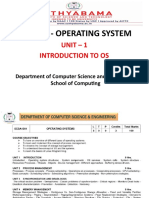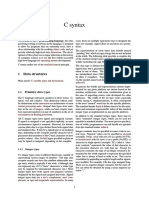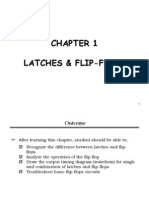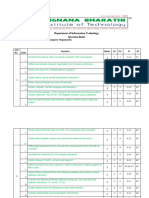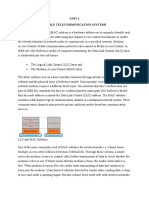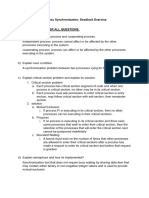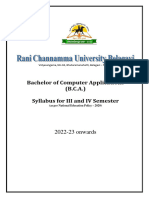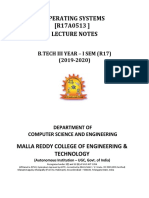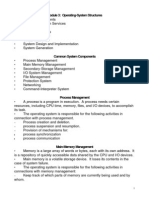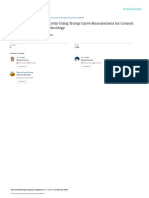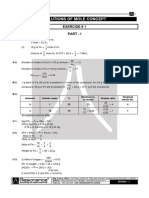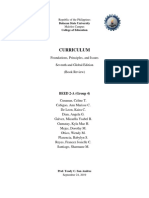OS Structure
Uploaded by
Ashwini AmbekarOS Structure
Uploaded by
Ashwini AmbekarSubject:
Subject:Operating
OperatingSystem
System Class:
Class:
TYCM
TYCM
CHAPTER : 2
Operating System Structures
Operating System Services
System Calls
Concept, Types and Uses
Operating System Structure
Simple, Layered, Monolithic, Microkernel.
System Components
Process Management, Main Memory
Management, File Management, I/O System
management, Secondary storage
management.
1
01
WINTER
Operating System Services
₳ Program execution – system capability to load a program
Template
into memory and to run it.
₳ I/O operations – since user programs cannot execute I/O
operations directly, the operating system must provide some
means to perform I/O.
₳ File-system manipulation – program capability to read,
write, create, and delete files.
₳ Communications – exchange of information between
processes executing either on the same computer or on
different systems tied together by a network. Implemented
via shared memory or message passing.
₳ Error detection – ensure correct computing by detecting
errors in the CPU and memory hardware, in I/O devices, or
in user programs.
2
01
Additional Operating System Services
Cont…
Additional functions exist not for helping the user,
but rather for ensuring efficient system operations.
1. Resource allocation – allocating resources to
multiple users or multiple jobs running at the
same time.
2. Accounting – keep track of and record which
users use how much and what kinds of computer
resources for account billing or for accumulating
usage statistics.
3. Protection – ensuring that all access to system
resources is controlled.
3
System Calls 02
System calls provide the interface between a running
program and the operating system.
Generally available as assembly-language
instructions.
Languages defined to replace assembly language for
systems programming allow system calls to be made
directly (e.g., C, C++)
Three general methods are used to pass parameters
between a running program and the operating
system.
Pass parameters in registers.
Store the parameters in a table in memory, and the table
address is passed as a parameter in a register.
Push (store) the parameters onto the stack by the program,
and pop off the stack by operating system
4
Passing of Parameters
As A Table 02 Cont…
5
MS-DOS Execution
1. Process Control 02 Cont…
Process Control
End, abort process
Load, execute process
Create process,
terminate process
Get process attribute,
set process attribute
Wait for time
Wait event, signal event
Allocate and free
memory
At System Start-up Running a Program
6
Other types of system Calls 02 Cont…
File Management
Create, Delete, Open, Close, Read-Write-reposition.
Get file attribute, set file attribute
Device Management
Request device, release device
Read, write, reposition
Get device attribute, set device attribute
Logically attach or detach devices
Information Maintenance
Get Time or date, set time or date
Get system data, set system data E.g. Current user, version no.
of OS, amount of free memory
Get process, file, or device attribute.
Set process file or device attribute
7
MS-DOS Simple System Structure 03
MS-DOS – written to
provide the most
functionality in the least
space
not divided into modules
Although MS-DOS has
some structure, its
interfaces and levels of
functionality are not well
separated
Fig: MS-DOS Structure
8
UNIX System Structure 03
WINTER
Cont…
Template
9
Layered Approach 03 Cont…
Modularization
Abstract and encapsulated implementation of an OS
The operating system is divided into a number of layers
(levels), each built on top of lower layers. The bottom layer
(layer 0), is the hardware; the highest (layer N) is the user
interface.
With modularity, layers are selected such that each uses
functions (operations) and services of only lower-level
layers.
Ease of Debugging
Each layer hide certain data structure, operations &
hardware of higher level layer
Need careful definition and interaction of each layer
Less efficient because of overhead to system call
E.g. OS/2, windows NT
10
An Operating System Layer 03 Cont…
11
OS/2 Layer Structure 03 Cont…
12
Microkernel System Structure 03 Cont…
Moves as much from the kernel into “user” space.
Remove all non-essential components from kernel
Provides communication facility and coordination
All new services are added to user space
Communication takes place between user modules (Client
Program) and services using message passing.
Benefits:
- easier to extend a microkernel
- easier to port the operating system to new architectures
- more reliable (less code is running in kernel mode)
- more secure and reliable
E. g. True64, QNX
13
Windows NT Client-Server
03
Structure
WINTER
Cont…
Template
14
Monolithic Structure 03 Cont…
Most primitive form of the OS, Practically no
structure
Characterized by a collection of procedures that can
call any other procedure
All procedures must have a well-defined interface
Does not allow information hiding (private functions
for procedures)
Services provided by putting parameters in well-
defined places and executing a supervisory call. eg.
CP/M and MS-DOS
15
Monolithic Structure 03 Cont…
Basic structure
Main program that invokes requested service procedures
Set of service procedures to carry out system calls
Set of utility procedures to help the service procedures
User program executes until
program terminates
program makes a service request
a time-out signal occurs
an external interrupt occurs
Problems with monolithic structure
Difficult to maintain
Difficult to take care of concurrency due to multiple users/jobs
16
Monolithic Structure 03
Cont..
17
04
WINTER
Common System Components Cont…
₳ Process Management
₳ Template
Main Memory Management
₳ File Management
₳ I/O System Management
₳ Secondary Management
Additional Components:
₳ Networking
₳ Protection System
₳ Command-Interpreter System
18
Process Management 04 Cont…
A process is a program in execution. A process needs certain
resources, including CPU time, memory, files, and I/O devices,
to accomplish its task.
E.g. compiler, a word processing program, print command etc.
A program is passive and process is active part of execution.
System and user processes
When a process terminates the OS will reclaim any reusable
resources.
The operating system is responsible for the following activities
in connection with process management.
Process creation and deletion.
process suspension and resumption.
Provision of mechanisms for:
process synchronization
process communication
19
Main-Memory Management 04 Cont…
Memory is a large array of words or bytes, each with its own
address. It is a repository of quickly accessible data shared by
the CPU and I/O devices.
For a program to be executed it must be mapped to absolute
address and loaded into memory
Instruction must be in memory for the CPU for execution.
Main memory is a volatile storage device. It loses its contents in
the case of system failure.
The operating system is responsible for the following activities
in connections with memory management:
Keep track of which parts of memory are currently being used
and by whom.
Decide which processes to load when memory space becomes
available.
Allocate and deallocate memory space as needed.
2
0
File Management 04 Cont…
A file is a collection of related information defined by its creator.
Commonly, files represent programs (both source and object
forms) and data.
Most visible component of an OS.
Files can be store on several type of physical media.
The operating system is responsible for the following activities in
connections with file management:
File creation and deletion.
Directory creation and deletion.
Support of primitives for manipulating files and directories.
Mapping files onto secondary storage.
File backup on stable (nonvolatile) storage media.
21
I/O System Management 04 Cont…
The I/O system consists of:
A buffer system
Speed mismatch
Different data transfer sizes
Copy semantics
A cache system- Fast memory
A spool system-holds output for a device
A general device-driver interface
Drivers for specific hardware devices
only the device driver knows the peculiarities of the
specific device to which it is assigned
22
04
WINTER
Secondary-Storage Management Cont…
Since main memory (primary storage) is volatile and too
small to accommodate all data and programs permanently,
Template
the computer system must provide secondary storage to
back up main memory.
Most modern computer systems use disks as the principle
on-line storage medium, for both programs and data.
The operating system is responsible for the following
activities in connection with disk management:
Free space management
Storage allocation
Disk scheduling
It is very efficient because of frequent use.
High speed
23
Networking (Distributed Systems) 04 Cont…
A distributed system is a collection of
processors that do not share memory or a clock.
Each processor has its own local memory.
The processors in the system are connected
through a communication network.
Communication takes place using a protocol.
A distributed system provides user access to
various system resources.
Access to a shared resource allows:
Computation speed-up
Increased data availability
Enhanced reliability
.
24
Protection System 04 Cont…
Protection refers to a mechanism for
controlling access by programs, processes, or
users to both system and user resources.
The protection mechanism must:
distinguish between authorized and
unauthorized usage.
specify the controls to be imposed.
provide a means of enforcement.
25
Command-Interpreter System 04 Cont…
One of the most important systems programs for an Operating
system is Command Interpreter.
Many commands are given to the operating system by control
statements which deal with:
process creation and management
I/O handling
secondary-storage management
main-memory management
file-system access
protection
Networking
Command Interpreter is the interface between the user & the OS
The program that reads and interprets control statements is called
variously:
command-line interpreter
shell (in UNIX)
Its function is to get and execute the next command statement.
26
END
27
You might also like
- Kidase English Tigrinya Geez 140712035700 Phpapp01No ratings yetKidase English Tigrinya Geez 140712035700 Phpapp01378 pages
- Operating Systems Structures: Jerry Breecher100% (1)Operating Systems Structures: Jerry Breecher22 pages
- Operating System: Operating Systems: Internals and Design PrinciplesNo ratings yetOperating System: Operating Systems: Internals and Design Principles81 pages
- Introduction-Basic Operating System, Resource AbstractionNo ratings yetIntroduction-Basic Operating System, Resource Abstraction20 pages
- Unit 2 Mobile Telecommunication Systems Medium Access Control (MAC) Address Is A Hardware Address Use To Uniquely Identify EachNo ratings yetUnit 2 Mobile Telecommunication Systems Medium Access Control (MAC) Address Is A Hardware Address Use To Uniquely Identify Each43 pages
- EC6013 Advanced Microprocessors and Microcontrollers PDFNo ratings yetEC6013 Advanced Microprocessors and Microcontrollers PDF8 pages
- Computer Architecture 3rd Edition by Moris Mano CH 12No ratings yetComputer Architecture 3rd Edition by Moris Mano CH 1221 pages
- William Stallings Computer Organization and Architecture 8 EditionNo ratings yetWilliam Stallings Computer Organization and Architecture 8 Edition55 pages
- Networking Basics: Dept. of Computer Science Faculty of Science and TechnologyNo ratings yetNetworking Basics: Dept. of Computer Science Faculty of Science and Technology33 pages
- Chapter 01 Introduction To Computer Organization and ArchitectureNo ratings yetChapter 01 Introduction To Computer Organization and Architecture47 pages
- CS2253 - Computer Organization and Architecture PDF100% (1)CS2253 - Computer Organization and Architecture PDF2 pages
- Operating System: Chapter - Process SynchronisationNo ratings yetOperating System: Chapter - Process Synchronisation86 pages
- Btech Cs 4 Sem Theory of Automata and Formal Languages kcs402 2022100% (1)Btech Cs 4 Sem Theory of Automata and Formal Languages kcs402 20222 pages
- Kernel I/O Subsystem in Operating SystemNo ratings yetKernel I/O Subsystem in Operating System2 pages
- Final Practical List Computer Peripherals and InterfaceNo ratings yetFinal Practical List Computer Peripherals and Interface42 pages
- Data Structure and Algorithm Lab ManualNo ratings yetData Structure and Algorithm Lab Manual40 pages
- Introduction To ICT - Exam Paper ANSWER SHEETNo ratings yetIntroduction To ICT - Exam Paper ANSWER SHEET19 pages
- Improvement of Productivity Using Tromp Curve MeasNo ratings yetImprovement of Productivity Using Tromp Curve Meas11 pages
- Practical Guidance For Bayesian Inference in AstronomyNo ratings yetPractical Guidance For Bayesian Inference in Astronomy10 pages
- Permutation Tests for Complex Data Theory Applications and Software Wiley Series in Probability and Statistics 1st Edition Fortunato Pesarin 2024 scribd download100% (5)Permutation Tests for Complex Data Theory Applications and Software Wiley Series in Probability and Statistics 1st Edition Fortunato Pesarin 2024 scribd download61 pages
- 2 - Bhuvaneswar - A Sociolinguistics Analysis ofNo ratings yet2 - Bhuvaneswar - A Sociolinguistics Analysis of38 pages
- Fake Credit Card Number Generator: No, You Can't Really Buy Anything With Them! Nice TryNo ratings yetFake Credit Card Number Generator: No, You Can't Really Buy Anything With Them! Nice Try2 pages
- Module 1 Hiragana To Katakana (Hiragana and Katakana)No ratings yetModule 1 Hiragana To Katakana (Hiragana and Katakana)13 pages
- Tle9 - Epas - Q2 - M5 - Discuss The Operation of An Electric Flat Ironits Parts and Functions100% (3)Tle9 - Epas - Q2 - M5 - Discuss The Operation of An Electric Flat Ironits Parts and Functions12 pages
- Accounting Grade 12 Baseline Assessment - QP100% (1)Accounting Grade 12 Baseline Assessment - QP11 pages
- The Family of Man - The Greatest Photographic Exhibition of All Time (Art Photo Edward Steichen)100% (10)The Family of Man - The Greatest Photographic Exhibition of All Time (Art Photo Edward Steichen)196 pages
- Plateefficiency Correlation in GAS P !) : Distllling AND Absorbers100% (1)Plateefficiency Correlation in GAS P !) : Distllling AND Absorbers13 pages
- Curriculum: Bulacan State University College of EducationNo ratings yetCurriculum: Bulacan State University College of Education9 pages
- Assignment:: 1. What Is An Information Security Assurance?No ratings yetAssignment:: 1. What Is An Information Security Assurance?3 pages






